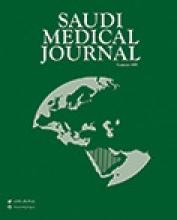Abstract
OBJECTIVE: To compare laparoscopy versus laparotomy management of tubal pregnancy and the reproductive outcome.
METHODS: A retrospective chart review of 81 patients admitted for management of tubal pregnancy was carried out at Riyadh Armed Forces Hospital from January 1998 until January 2000. The patients were divided according to surgical procedure performed into: Group I (33 patients) laparoscopy and group II (48 patients) laparotomy. We evaluated pre and postoperative serum b-human chorionic gonadotrophin levels, total operating time, total blood loss or blood transfusion or both, duration of hospital stay, recurrence rates of ectopic pregnancy and future fertility outcome for all patients.
RESULTS: No differences were found between both groups in patient age, parity, size of adnexal mass, condition at the time of presentation, site of tubal pregnancy, previous history of ectopic, pre and postoperative serum b-human chorionic gonadotrophin and the total operating time. There were significant reductions of total blood loss, number of blood transfusion units, and duration of hospital stay, in the laparoscopic group compared to the laparotomy group. A total of 54 patients desired pregnancy, 23 patients in the laparoscopy and 31 patients in the laparotomy group. No significant differences were found in the fertility outcome between both groups. The rates of subsequent intrauterine pregnancy were 74% (17/23) in the laparoscopy group and 61%, (19/31) in the laparotomy group and the rates of subsequent ectopic pregnancy were 4% (1/23) in the laparoscopy group and 10% (3/31) in the laparotomy group.
CONCLUSION: Laparoscopic treatment of ectopic pregnancy in hemodynamically stable patients offers major economic benefits superior to laparotomy in terms of less need for blood transfusion, shorter duration of hospital stay and convalescence.
- Copyright: © Saudi Medical Journal
This is an open-access article distributed under the terms of the Creative Commons Attribution-Noncommercial-Share Alike 3.0 Unported, which permits unrestricted use, distribution, and reproduction in any medium, provided the original work is properly cited.






